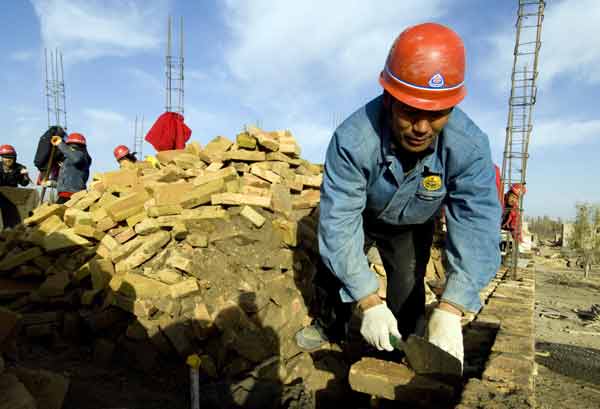Government and Policy
Latest batch of officials head to Xinjiang
By Shao Wei (China Daily)
Updated: 2011-02-10 07:51
 |
Large Medium Small |
 |
|
A worker lays bricks at a housing project for an assistance program in Poskam county of the Xinjiang Uygur autonomous region on Nov 13, 2010. With assistance from Shanghai, more than 130,000 farmers and herdsmen in the region will benefit from the housing program. [Photo/Xinhua] |
The visitors are among 2,514 officials and experts who have been arriving in the region since late December, according to the organization department of the Communist Party of China (CPC) Xinjiang committee.
These officials, the seventh batch of experts to assist Xinjiang, will work in the remote region for periods of 18 months or three years.
The latest group is much larger than any of the previous six groups which totaled less than 3,800 members, according to the organization department.
Liu Yong, 46, from Shandong province, is one official who has brought his expertise and experience in the more developed eastern region to Xinjiang.
From July 2008 to this January, Liu worked as the deputy headmaster of No 2 Middle School in Kashgar prefecture in southern Xinjiang, where more than 90 percent of the population is Uygur.
Lack of knowledge and expertise is the biggest hurdle to development in Xinjiang, Liu told to China Daily. "But that's why we're assigned to work here. It's an honorable mission.
"At the beginning, I was reluctant to go (to Xinjiang), as it's a distant and poor area.
"But I quickly got used to the conditions. After experiencing a dozen earthquakes in Kashgar, I can even sleep well when the earth is shaking."
During his stay in Xinjiang, Liu experienced the terrorist attack in Kashgar on Aug 4, 2008, and the riot in Xinjiang's capital, Urumqi, on July 5, 2009.
The Kashgar attack outside a border police division left 17 police officers dead and 15 others injured while the Urumqi riot left 197 people dead and more than 1,700 injured, according to official figures.
"To be honest, I was scared," Liu said. "In those tense days, each time I called my family in Shandong, I cried in silence when I heard their voices."
Liu said during that period everyone in his school was told to go out with at least two or three companions after 9 pm.
However, Liu and his colleagues never flinched in the face of such tough conditions.
After 13 years of assistance from Shandong province, Kashgar No 2 Middle School has become the best and biggest middle school in southern Xinjiang.
In 2010, more than 90 percent of the school graduates scored higher than the minimum points for college enrollment in the national college entrance exam, while in 1997 the percentage was around 50.
Compared with other western regions, Xinjiang lags further behind the country's eastern areas. As a result, the central government has sketched a detailed route map for the area's development from 2011 to 2020.
In the proposal for the 12th Five-Year Plan (2011-2015), the CPC Central Committee said the country will continue to give priority to the development of western areas and intensify support for Xinjiang, Tibet and other regions.
By 2015, Xinjiang's per capita gross production will reach the nation's average level, and by 2020 it will realize the goal of building a moderately prosperous society.
To assist in achieving that goal, 19 provinces and municipalities that are assisting Xinjiang plan to invest more than 10 billion yuan ($1.52 billion) in the region this year, according to the Xinjiang regional government.
In April, a delegation of senior officials from the 19 provinces and cities will inspect Xinjiang to make a more detailed assistance plan.
In 2010, 99 pilot projects, with a total investment of 3.6 billion yuan, were launched to boost local economic development, improve people's living standards and protect the environment, according to the Xinjiang regional government.
China Daily
(China Daily 02/10/2011 page5)